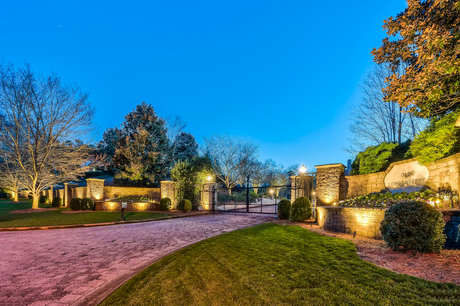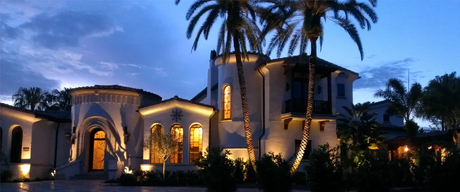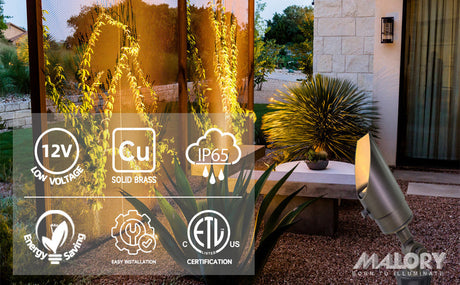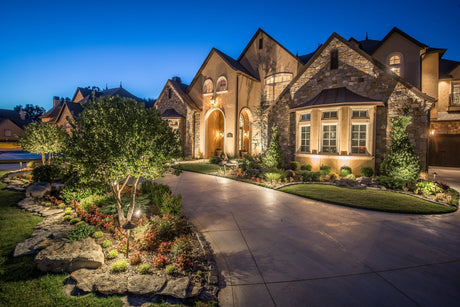Choosing the right color temperature for your landscape lighting is one of the most important steps in creating a beautiful, balanced, and functional outdoor space. Whether you’re illuminating a walkway, highlighting trees, or accentuating architectural features, the color temperature determines how your lighting feels — warm and inviting or cool and dramatic. Understanding this balance helps homeowners achieve professional-quality outdoor lighting results without trial and error.
Understanding Color Temperature
Color temperature is measured in Kelvin (K), indicating the appearance of light from warm (yellow) to cool (white/blue).
Here’s a quick guide:
- 2700K – 3000K (Warm White): Soft, inviting light similar to traditional incandescent bulbs. Perfect for gardens, patios, and residential landscapes where a cozy atmosphere is desired.
- 3500K – 4000K (Neutral White): Balanced lighting that enhances visibility while maintaining warmth. Ideal for pathways, driveways, and architectural accents.
- 5000K – 6000K (Cool White): Bright, crisp light resembling daylight. Commonly used for security or commercial outdoor lighting applications.
According to the Illuminating Engineering Society (IES), warm white lighting (2700K–3000K) is most recommended for residential landscape lighting, as it enhances natural colors while minimizing glare.
Why Color Temperature Matters in Landscape Lighting
Color temperature influences more than appearance — it affects ambiance, visibility, and mood.
- Warm tones (2700K–3000K) make foliage appear lush and rich, ideal for gardens and social spaces.
- Cool tones (4000K–5000K) bring out sharper details, emphasizing architectural textures or water features.
A 2024 Lighting Research Center study found that lighting temperature can change human perception by up to 30%, altering how bright or comfortable a space feels. This means choosing the right Kelvin level can transform a backyard from harsh to harmonious.

Selecting the Right Brightness for Outdoor Lighting
While color temperature determines the tone, brightness (measured in lumens) defines visibility.
For landscape lighting, aim for the following general brightness ranges:
| Lighting Area | Recommended Lumens | Suggested Temperature |
|---|---|---|
| Pathways & Walkways | 100–200 lm | 2700K–3000K |
| Garden Beds | 200–400 lm | 2700K–3500K |
| Trees & Shrubs | 400–700 lm | 3000K–4000K |
| Architectural Features | 700–1200 lm | 4000K–5000K |
| Water Features | 200–600 lm | 3000K–4000K |
Using low voltage LED landscape lighting not only ensures efficiency but also gives you better control over brightness and beam spread. Studies show that LED systems reduce energy consumption by up to 80% compared to traditional halogen fixtures.
Balancing Warmth and Function
Every outdoor area has its own purpose — and the best lighting matches both form and function.
- For entertainment zones: Choose 2700K–3000K for a welcoming glow that complements gatherings.
- For safety paths: Opt for 3000K–3500K with moderate brightness to increase visibility without harsh glare.
- For architectural highlights: Use 4000K–5000K to bring out the contrast and structure of walls or statues.
In most residential projects, blending multiple temperatures creates depth. For example, warm lights for plant beds paired with neutral tones for walkways achieve visual harmony and enhance nighttime aesthetics.
Common Mistakes to Avoid
- Using one color temperature everywhere: This flattens the landscape. Layering different tones adds dimension.
- Over-lighting small areas: Too much brightness causes glare and wastes energy.
- Ignoring CRI (Color Rendering Index): Choose fixtures with CRI 85+ for accurate color representation of plants and surfaces.
- Skipping beam angle control: Adjustable spotlights and path lights help direct light precisely where needed, reducing light pollution.

Professional Tips for Outdoor Lighting Design
- Combine uplighting and downlighting techniques to create balance and texture.
- Place warm lighting near natural elements (trees, flowers) and cooler lighting on stone or water surfaces.
- Use low voltage landscape lighting transformers for safer and more energy-efficient systems.
- Always test color temperature at night before final installation — daylight can distort perception.
A well-designed landscape lighting system should mimic natural light transitions — subtle, layered, and comfortable to the eye.
Final Thoughts
Selecting the right color temperature and brightness is key to creating a stunning and functional outdoor environment. A thoughtful combination of outdoor lighting warmth and intensity enhances not only the visual appeal but also the comfort and safety of your space.
By choosing durable, low-voltage brass fixtures and energy-efficient LEDs, homeowners can enjoy long-lasting performance and lower maintenance costs — all while elevating the beauty of their garden after dark.
Well-planned landscape lighting transforms your outdoor area into a glowing extension of your home — inviting, elegant, and uniquely yours.









